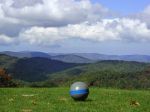by Rick Vogel
I am not a golfer, but I am a fan of this blog site. I live in a golf community, and it is fun to compare the benefits of being a non-golfer on a golf course to those of the golfing readers of Golf Community Reviews. I feel somewhat qualified to answer the question, “What positive experiences might await the non-golfer who will own a home on the course?” Surprisingly, the answer is “quite a few” and, except indirectly, none are actually related to the game.
The course that we live on with our dog, Goldie, 30 miles north of Asheville, NC, is the Wolf Laurel Country Club. It is a private club and, in a few ways, not exactly a typical golf course. First, when it was built in the late ‘60s, it was, and may still be, at the highest altitude of any course east of the Rockies. For example, the 4th tee, the highest point on the course, is 4,800 feet above sea level.
It is a private club and, in a few ways, not exactly a typical golf course. First, when it was built in the late ‘60s, it was, and may still be, at the highest altitude of any course east of the Rockies. For example, the 4th tee, the highest point on the course, is 4,800 feet above sea level.
Another reason the course is not typical is it is only open for play from May 1st until the end of October, a six-month season due mostly to weather at these elevations. This year, the course endured a total of 118 inches of snow, almost 10 feet, during the six months it was closed!
The fairways at Wolf Laurel turn into a hikers paradise for those six months (assuming no blizzards). For those of us who live on the course, but do not play golf, the 5,000 acres that make up Wolf Laurel provide access to some of the most interesting hiking experiences anywhere. This is no mean feat, considering that the local competition, the Appalachian Trail, makes up the northern boundary of our ski and golf resort.
From a golfer's perspective, the things that make this course a joy to hike can make it a challenge to play. For example, some of the best long-range views while hiking the course are from the tee of the 10th hole, a par five of 535 yards but with a drop of about 200 feet from tee to green. The views are stunning, but the golf daunting.
The course features tree-lined fairways that seem deceptively narrow along the mountain ridges that define the course. On some holes you can kiss your Bridgestone Tour 330 goodbye if you don't keep it straight down the fairway. Sheer drop-offs formed by mountain streams on both sides leave no way for recovery.
When not hosting golfers, the course attracts the area's abundant wildlife. Small herds of white tail deer graze the fairways, sometimes to the considerable consternation of the greens keepers. The deer were here first, the damage is minimal, and so it's only fair that they get to "play" the course. Red foxes, rabbits, raccoons, the occasional bobcat, black bear and Northern water snake, along with myriad other critters, drink and hunt at the frog- and fish-inhabited water hazards.
Surely the age of the Wolf Laurel golf course, along with Mother Nature, has caused the softening of manmade features that now make it difficult to distinguish water hazards from natural ponds and some of the higher fairways from the natural balds of the southern Appalachian mountains. Certainly, there is an argument to be made concerning the pros and cons of golf courses and their effect on the environment, but in my opinion it is possible to integrate them into the natural landscape in a manner described by the legendary designer Pete Dye, when he said of his Bulle Rock course in Havre de Grace, MD, "I did not undo God's work."
*
Former innkeeper Rick Vogel lives in the golf community of Wolf Laurel north of Asheville, NC. He doesn't play golf but he appreciates having a golf course at the core of his development. His last article for us, about the glories of finding golf balls in the weeds, attracted the most comments of any article ever written in this space. Photo courtesy of Wolf Laurel Country Club.



